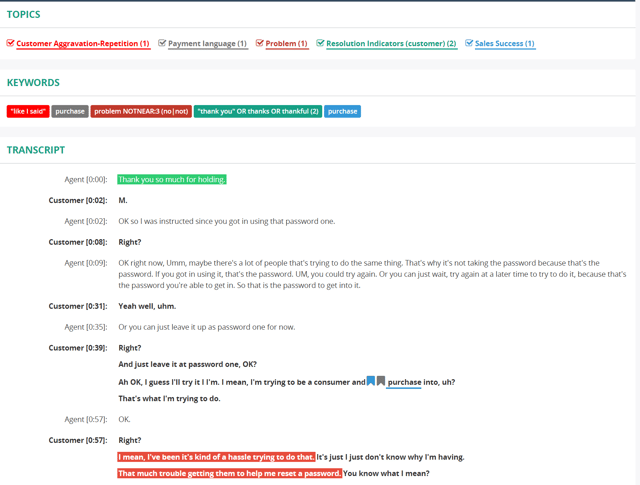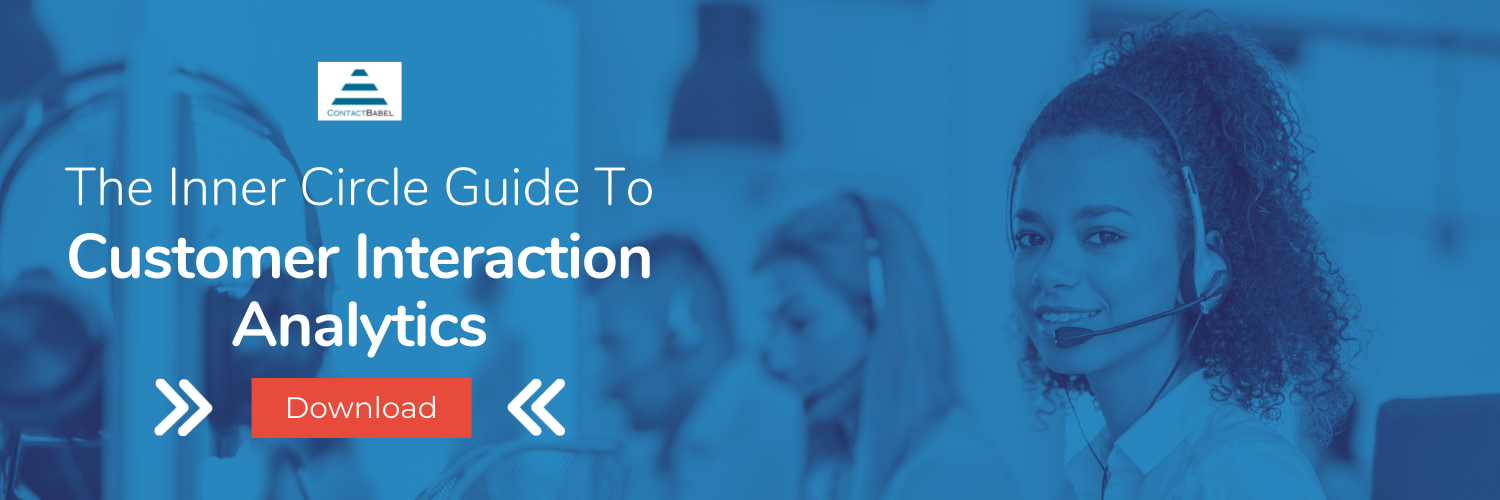Why You Should Start Tagging Every Contact Center Call Now
Contact center managers having access to call recordings isn't new. A poll done in 2015 on Callcentrehelper.com showed that 95% of supervisors had access to those recordings. However, we know from experience that, traditionally, only 1-2% of all recordings are actually listened to for quality assurance and agent evaluation.
This means that if you have a contact center with 100 agents taking, on average, 50 calls a day, you will review only 50-100 calls out of 5,000 daily customer interactions. The chance of you getting a representative picture of what is going on in your contact center is about equal to the odds that an NFL kickoff will be returned for a touchdown (1:270)!
But even worse than the bad odds in picking the right call to evaluate your agents' performance is that all this valuable information your customers are giving is completely inaccessible and goes to waste.
In other words, you have thousands of customers telling you what they like and don't like about your company, your product/services, and your competition every day, yet you have no way of aggregating and visualizing that incredibly insightful data!
This is where call tagging comes in.
What Is Call Tagging?
Call tagging (also sometimes called call categorization) refers to the adding of contextual labels to a call recording. This can happen manually or automatically.
Simple Manual
The simplest, low-tech way of call tagging would be having a supervisor listen to a completed call. For example, a customer called to complain that their online order placed over a week ago still hasn't arrived. You could add tags such as "shipping delays", "online order issue", and "support attention needed".
Manual With Transcript
However, in most contact centers, call recordings are transcribed for compliance and quality assurance. Because reading a transcript is usually done twice as fast as listening to a call, a supervisor could quickly scan the text to pick out keywords and phrases and tag the call accordingly.
Semi-Automatic With Keyword Spotting
MiaRec takes it another step further with its automatic keyword spotting. After the call recording has finished and the transcript has been completed, our AI-powered speech engine will automatically search for predefined keywords and key phrases, highlight and color-code them in the text, and then assign them as topics.

This way, as a supervisor, you can recognize at a glance the call sentiment (i.e., a lot of our customers choose green tones for positive sentiments versus red tones which often stand for something that is wrong and needs attention).
The screenshot above shows the transcript part of the call summary card. If you scroll up, you can see the keywords and phrases MiaRec has identified and the topics it has associated with the call.
.png?width=640&height=360&name=Screenshots%20(13).png)
MiaRec's speech engine is very flexible because a customer rarely uses the exact key phrase we save in the keyword bank. They might use variations of it, like "The product I received is broken" or "The product doesn't work anymore".
Once you start tagging calls, you can get a clear picture of what is happening right now in your call center and how it changes over time.
How Call Tagging Can Help Your Contact Center & Business Operations
Call tagging can not only make your contact center run more efficiently, but also help inform business decisions, improve marketing and sales effectiveness, and much more.
Impact On Your Contact Center
Call tagging can enable you to increase your contact center efficiency, boost agent productivity, and improve customer experiences. Below are just a few examples of how tagging can be used, but there are many more ways you can add context to your recordings.
Identify Agent Insecurities, Training Gaps/Opportunities, & Process Inefficiencies
One very popular example of how call tagging can be used is when it is utilized to monitor and improve the agents' performance, identify potential gaps and opportunities for additional training, and even find ways to streamline the processes. For example, is your agent using phrases like "Ahem, let me check", "Hold on, our computer system is very slow today", or "Can you hold on for a minute while I ask my colleague"? This could indicate that they might need additional training, are having trouble finding the information they need, and more.
Quality Assurance
Another great example is using call tagging to ensure service quality. Are your agents using the opening and ending statements they are supposed to according to their script? Are they using positive, reassuring language to resolve a difficult situation? By creating topics and associated keywords around those, you can easily check (and even automatically evaluate your agents' performance).
.png?width=640&height=360&name=Screenshots%20(7).png)
Checking For Regulatory Compliance
Call tagging can also be used to check for adherence to compliance protocols. For example, if your communication solution does not automatically announce the call recording (i.e., if you have a Cisco platform), you can check if your agent is opening the call with "This call is being recorded." Depending on your industry, your specific compliance regulations, and your business, you might also want to check whether or not your agent is pausing the recording before taking the customer's credit card details and such.
Impact On Other Business Units
Call tagging can also be very helpful outside of the contact center.
Support Marketing Efforts
Call tagging provides very valuable insights for your marketing team. For example, it could be used to:
- Inform the team what marketing campaign is successful or is totally missing the mark by listening to direct customer feedback, what current customer concerns need to be addressed (maybe you offer a certain product feature that your customers are not aware of but they mention that your competition has it), and more.
- Create contact segmentation lists for a specific campaign (e.g., all customers who recently had a bad product/customer service experience, mentioned a certain product feature as important, or requested a refund).
- Personalize your marketing efforts. By using the insights you gain through call tagging, you could make your website and other customer interactions much more targeted and contextual.
Boost Sales & Customer Retention
In addition to informing your marketing team, call tagging could enable your sales team to be more effective. You could use these insights to identify cross- and upsell opportunities as well as potential customer success issues within your customer base. For example, customers who mention that they will "switch to [competitor name]" or who are at risk of moving to another provider because of a bad customer experience could be flagged for follow-up.
You could also use the gathered information to identify buying obstacles. Are your prospects mentioning pricing or are they confused about how the product works? Changes in the pricing structure or better product information could help!
Product Development
Last, but certainly not least, is product development. By mining thousands of calls from customers who directly interact with your product, you receive much more honest and direct feedback than you would get by surveying your customer base or by running focus groups. This can also inform your product strategy as you can now understand which features people love/hate/have trouble with, which they aren't using, or which they wish your product had.
These are just a few examples of how call tagging could be used, but with a little creativity, the sky is the limit! With MiaRec, you can constantly add new topics and fine-tune existing ones to keep current with the changing market conditions.
AI & Automation Increasingly Used To Surface Valuable Insights From Call Recordings
If you are asking yourself how many of your competitors are already doing this or have active plans to implement this in the near future, the answer is many. This has significantly increased since the start of the pandemic when the difficulty of calls, call length, and customer frustration exploded overnight.
According to a recent Deloitte study, 76% of contact center executives plan to invest in technologies such as artificial intelligence (AI) and process automation to improve their customers' experience and contact center efficiency. In addition, 56% of the respondents said that they will focus on AI which they see as ready for broad adoption.
To learn more on how you can leverage call tagging and customer interaction analytics, download "The Inner Circle Guide To Customer Interaction Analytics" or schedule a demo to experience MiaRec's Voice Analytics first hand.
You May Also Like
These Related Stories

26 Contact Center Analytics Software Terms You Should Know

5 Mistakes Companies Make In Phone Support & How To Fix Them
.png)

